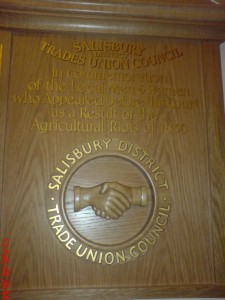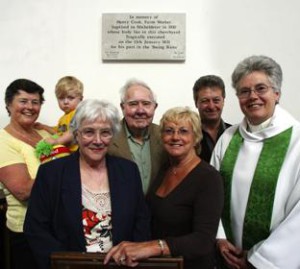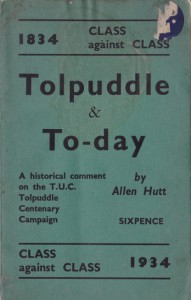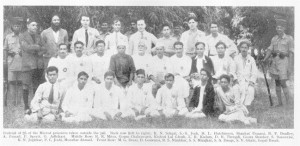A few years ago Bristol Radical History Group published a pamphlet entitled Tolpuddle and Swing: The Flea and the Elephant [ 1 ]which critiqued the centrality of the Tolpuddle Martyrs incident (1833-34) to Trade Union history whilst the massive uprising of rural wage-labourers which occurred a few years previously, known as the ‘Captain Swing riots’ (1830-31), had been pretty much ignored. The pamphlet essentially came about because of admirable efforts by Trade Unionists in Wiltshire and Hampshire in 2009 to highlight the Swing rising[ 2 ] . Local branches of Unison and Unite raised money to put up (long-overdue) historical plaques to commemorate the rural labourers who were executed or transported for their involvement in the movement . [ 3 ]


The first part of the BRHG pamphlet concentrates on the reasons why the Tolpuddle event was considered a useful propaganda tool by some of the leaders of the Trade Union movement in 19th C. It is argued that Tolpuddle story ticked all the boxes; notably a ‘victim centred narrative’, formal (Methodist) organisation, non-violence and the outrageous use of a ‘mutiny’ law by a ‘treacherous’ Whig government to convict five ‘innocent’ rural labourers. All of these factors made the six Tolpuddle victims ‘respectable’ and ‘valid’, whereas the thousands of Swing ‘rioters’, destroyed property, were clearly ‘guilty’, were not part of a formal (religious) organisation and consequently ‘invalid’ and thus of no useful propaganda value to reformists. So they were ignored, despite their historical and political importance[ 4 ] and, of course, the immense suffering of the convicted and their families at the hands of the British state[ 5 ].
After the publication of the Tolpuddle and Swing pamphlet Bristol Radical History Group were criticised by two South West TUC committee members for being ‘anti-union’ and for belittling the Tolpuddle history. However, in a debate at the Radical History School at Tolpuddle in 2010, one of the protagonists made a curious comment which referred to similar criticisms of the TUC leadership over these issues in 1934! A few weeks ago BRHG discovered the basis of these historical criticisms when we obtained a copy of an original pamphlet entitled Class against Class: Tolpuddle & Today, A historical comment on the T.U.C. Tolpuddle Centenary Campaign 1834-1934 by Allen Hutt, a Communist Party member and journalist for the Daily Worker.

Hutt’s sarcastic and angry booklet was written in response to the Trades Union Congress celebration of the 100th anniversary of the Tolpuddle incident in 1934. In the opening salvoes Hutt argues that:
the working class is always ready to honour its heroes and martyrs, and George and James Loveless and their comrades[ 6 ] are deserving of honour; but let us ask ourselves just why the Trades Union Congress is making these exceptional efforts to put over the Tolpuddle centenary in such a big way

He goes on to point out that:
pious talk and burning incense over shrines can be a most useful cover for aspects of present actions and policy over which it is designed to draw a veil. One notes, for instance, the biting contrast between the solicitude of the General Council for the trade union martyrs who suffered a century ago, and its very different attitude to the trade union martyrs of our own day.
Hutt’s contemporary example of this hypocrisy was the Meerut Conspiracy. In 1929 a group of Indian Trade Unionists were retrospectively arrested for organising a railway strike in Meerut in the Indian state of Uttar Pradesh. The thirty-two men were imprisoned for nearly four years before the being brought to court in 1933, where the British state unleashed the Indian Penal Code, which declared:
Whoever within or without British India conspires to commit any of the offenses punishable by Section 121 or to deprive the King of the sovereignty of British India or any part thereof, or conspires to overawe, by means of criminal force or the show of criminal force, the Government of India or any local Government, shall be punished with transportation for life, or any shorter term, or with imprisonment of either description which may extend to ten years.[ 7 ]

Twenty-seven of the accused men were convicted with various durations of ‘transportation’; with Muzaffar Ahmed transported for life and five others given transportation for 12 years[ 8 ]. The strange parallels in the use of a ‘mutiny’ law against the Tolpuddle Martyrs and the Meerut defendants and the similarities in the form of the sentences were not lost on Hutt who stated:
Where were the General Council’s great demonstrations for the Meerut martyrs, sentenced to long terms of imprisonment and to transportation for precisely the same “crime” as the Tolpuddle men? History answers us: the General Council acquiesced in the Meerut outrage, the General Council for years did not raise a finger to secure the release of the Meerut prisoners, the General Council sabotaged the Meerut release campaign. Why? Because the General Council was associated with the Government, the second Labour Government, which was actually carrying on the trial. In 1834 it was Melbourne the Whig who put away working-men because they dared to form trade unions. A hundred years later it was MacDonald, the Labourite, who put away working-men because they dared to form trade unions.
Hutt’s vitriol for the TUC General Council did not end here, he continued:
the Tolpuddle memorial cottages, essay competition and brass bands serve the purpose of concealing form the working-class today the real significance of the most vital (and most forgotten) formative period of the Labour movement in this country. For it is already clear that the campaign of the Trades Union Congress is intended to concentrate all attention on this one incident of a whole historical period…The Lovelesses and their comrades did not hold the advanced views that typified working-men in the industrial centres at that time[ 9 ]; neither had they led a strike or even demanded wage increases. Indeed it was precisely the respectability and moderate attitude of the Tolpuddle men (they were all Methodists and two of them were well-known local lay preachers) that made the Government’s attack on them so peculiarly scandalous
Hutt recognised the Judeo-Christian narrative at the core of the Tolpuddle ‘story’ arguing:
The General Council are lavishing such minute attention upon the Tolpuddle martyrs because they wish to make these humble heroes of the working class posthumously play the part of John the Baptist to the Mondist[ 10 ] Messiah
…and counter-posed this with the silences of the TUC General Council regarding:
militant and revolutionary fighters [of the period] who dared all, hesitating before no legal terrors, in striving to win victory for their class
Hutt then offers us the ‘silences’ of the Tolpuddle era including the violent struggles under and against the Combination Acts (introduced in 1799 and repealed in 1824), the armed uprising in Merthyr and Dowlais in 1831, the Glasgow cotton-spinners transported for setting fire to Mills and killing black legs in 1838, the Newport rising of 1839 and the pitched musket battles of the Manchester brickmakers’ strike of 1843. All had been conspicuously ignored by the TUC and as Hutt noted:
we are not concerned here to bandy martyrs with the General Council…what is really important to the working class today is not simply who the Tolpuddle Martyrs were, but what was the movement of which they were a part…the fact is the eighteen-thirties were a revolutionary period…but everybody does not grasp the real meaning of this period in the history of our movement, and the Trades Union Congress is not going to help them do so. For the Tolpuddle campaign, as we have already suggested, tears one incident from the context of its period; and the result is, naturally, a complete distortion and confusion of the significance of that period to us today
The parallels in Hutt’s critique of the Tolpuddle narrative 80 years ago and the BRHG pamphlet of 2010 are striking. As such ‘Tolpuddle and Swing’ apparently falls into an ongoing tradition within the Trade Union movement of critiquing the centrality and the silences surrounding its ‘founding myth’.
(RB 29-06-14)
-
[ 1 ]
R. Ball Tolpuddle and Swing: The Flea and the Elephant Bristol Radical Pamphleteer #12 (2010)
-
[ 2 ]
There are very few memorials to the Swing risings. In February 2009, the Wiltshire plaque was unveiled in Salisbury Guild Hall, where many of the ‘rioters’ were tried and convicted. A second plaque, to commemorate the executed Henry Cook, was unveiled in Micheldever village church in Hampshire in June 2009. Plaque commemorates Henry Cook who died after Swing Riots – The Daily Echo
-
[ 3 ]
There were nearly 2000 ‘Swing’ trials in 1830-31, of which 252 people were sentenced to death (19 were actually executed), 644 imprisoned and nearly 500 transported to Australia for terms of 7 to 14 years with little hope of ever returning. This was the largest group of prisoners ever transported from England for a common crime.
-
[ 4 ]
It was argued by some commentators of the time and contemporary historians that the ‘Swing Uprising’ brought the anti-reform Tory government down in November 1830 which eventually led to the Great Reform act of 1832 and the first phase of enfranchisement.
-
[ 5 ]
The authors of the seminal work on the Captain Swing uprising stated in summing up the affects of the state repression: “in the south of England, there were whole communities that, for a generation, were stricken by the blow. From no other protest movement of the kind – from neither Luddites nor Chartists, nor trade unionists – was such a bitter price exacted”. E.J Hobsbawm and G. Rudé, Captain Swing (Harmondsworth: Penguin University Books, 1973) p.225.
-
[ 6 ]
The Loveless brothers and their four comrades were known as the ‘Tolpuddle Martyrs’.
-
[ 7 ]
Although none of the Indian defendants were self-confessed ‘Communists’, the British state was worried about the growing influence of the Communist International and used the trial to try to interdict organizing efforts by the fledgling Communist Party of India. In this sense, the trial was not only a failure but actively encouraged the growth of the CPI. – Wipkipedia
-
[ 8 ]
The outrage caused by the case in India, which massively helped the formation of the Indian Communist Party, forced the authorities to reduce some of the sentences on appeal in August 1933.
-
[ 9 ]
The BRHG pamphlet ‘Tolpuddle and Swing’ criticises this ‘classical’ Marxist disdain for the revolutionary potential of the rural proletarian.
-
[ 10 ]
“Mondism named after the industrialist Alfred Mond, was a system first mooted in Britain during the late 1920s whereby trade unions would attempt to maintain working-class living standards and assist industrial efficiency by cooperating with employers. Strongly supported by right-wing trade union leaders, it was condemned on the left as class collaboration” – maxist.org.